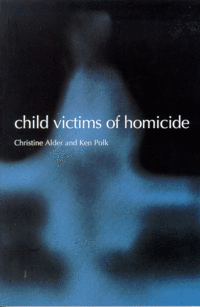

![]()
![]()

The difficulty in explaining homicide, that is, the killing of one person by another, is that there are multitude of different events that are defined as homicide. In order to make some sense of homicide, writers have been compelled to focus on one category of people or events, whether it be the victims, the offenders, the type of relationship between the two, or the type of homicide (e.g. Polk, 1994;. Fishbain et al., 1985; Esteal, 1993; Barnes, 2000; Barnes, 2001).
In Child Victims of Homicide, Alder and Polk have similarly arranged their findings around gender and social relationships: '(I)n approaching the study of children as victims of homicide, we argue that the analysis must negotiate through, first, the social context (whether the killing occurs within or outside the family) and second, the sex of the offender' (p. 31).
Beginning with 'Neonaticide' (chapter three) by mothers, and working through "Mothers who kill (chapter four), "Male family members who kill (chapter five) and "Killing outside the family" (chapter six), the major portion of the book is taken up with describing the different scenarios in which children die, and by whose hand.
Chapter seven, 'Observations about Child Homicide' is an attempt to find some ordering to the diverse patterns in child homicide, which may help to develop and advance the understanding of child homicide. Using their own data, and a number of different scenarios of homicide in which children are involved (but are not included in their own study), they argue that 'child homicide is definitively a matter of social context, gendered offending and, as the child ages, gendered risk' (p.142). They dichotomise the social context into family and non-family, but argue against the idea of a family to stranger continuum, and instead advance the idea of 'a variety of emergent social relationships and settings' (p. 145) that develop as children move through their young lives. The authors argue that in the early years there is a 'significant risk of homicide' (p. 142) regardless of whether the victim is male or female, and where women are the most prevalent offenders. In the middle years of childhood the distinctive characteristic is the low risk of homicide, and in late childhood, and especially late adolescence, the risk again becomes greater – but this time both victims and offenders are more likely to be male.
Readers hoping that the final chapter, 'Towards a Theoretical Analysis of Child Homicide,' will provide a neat theory to explain child homicide, will be disappointed. As discussed at the beginning of this review, homicide is a diverse phenomenon with many different scenarios and motivations, and as the authors say, '(c)hild homicides are so varied that it seems to us that it is unlikely that a single, unitary theory of homicide will provide a meaningful understanding' (p. 168). Instead, the chapter focuses on three clusters of features to understand different types of child homicide event. The first cluster is the observation that offenders in a variety of situations experience a feeling that their own well-being is under threat in some way, either directly or indirectly, from the victim. The second cluster 'relates to the offender's understandings of self and other, and the relationships between these, that allow them to legitimise their action' (p. 168), and the third cluster relates to the alternative options offenders have to change the circumstances which have led to the stresses that lead to the violent act of homicide. This last cluster is the one that the authors seem most confident in putting forward to explain child homicide – '(A) persistent theme both in our account and in those of other investigators of child homicide in young families is that of economic abandonment' – economic stress leading to patterns of hopelessness, despair, alcoholism and finally violence.
This is an interesting account of the multi-dimensional event of homicide, which so far has proven difficult to explain. The authors have made a major contribution to the field of homicide research, and they are to be commended on their detailed analysis.
Jo Barnes
University of Waikato (NZ)
BARNES, J. (2001) 'The Use of Firearms in Intimate Murder-Suicide in Australia and New Zealand', New Zealand Sociology, Vol 16, No. 1, June.
ESTEAL, P. (1993) 'Homicide between Adult Sexual Intimates: A Research Agenda', Australian & New Zealand Journal of Criminology, No. 26, March, pp. 3- 18.
FISHBAIN Rae, V.J. & ALDRICH, T.E. (1985) 'Female Homicide- Suicide Perpetrators: A Controlled Study', Journal of Forensic Sciences JFSCA, Vol. 30, No. 4, pp. 1148-1156.
POLK, K. (1994) When Men Kill: Scenarios of Masculine Violence. Melbourne: Cambridge University Press.
SILVERMAN R.A. & KENNEDY L.W. (1988) 'Women who Kill Their Children' Violence and Victims, Vol. 3, No. 2, pp. 113-127.